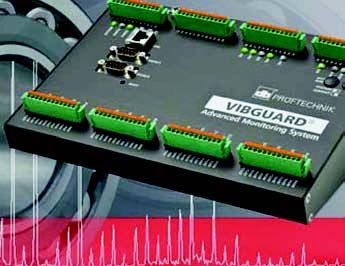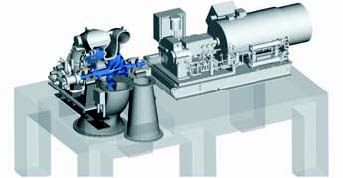New Products & Services: January/February 2014
Dresser-Rand KG2-3G/GO
The Dresser-Rand KG2-3G/GO 1.85 MW gas turbine with Ener-Core Gradual Oxidizer Technology runs directly on low-pressure, low-quality gases that otherwise could not be used. The system integrates oxidation technology from Ener-Core with the field-proven 2 MW-KG2-3G gas turbine to generate electricity with low emissions. It is suited to continuous or emergency stand-by power supply. A start reliability of 99.3%, full-load, throw-on capacity and minimal maintenance requirements are combined with a Gradual Oxidizer that can operate on low quality gaseous fuel.
“Ener-Core oxidizes low-quality gases instead of combusting them to produce heat and destroy contaminants,” said Thomas Logan, Director of Product Management for Environmental Solutions, Dresser-Rand. “The KG2-3G/GO can run on gas with a BTU too low to combust, yet can produce power. Some might use it to buy fuel to mix with low-quality waste gas to then burn it.” www.ener-core.com and www.dresser-rand.com

VIBGUARD online condition monitoring[/caption]
Vibguard online condition monitoring
Produced by Prüftechnik, Vibguard continuously and simultaneously records the machine signals on 20 channels and converts them to overall readings, spectrums or time signals. This facilitates monitoring in the case of rapidly changing operating conditions and combines condition monitoring and process monitoring. Fast processors, intelligent algorithms, modularity and flexibility make the system a useful monitoring and diagnostic tool. www.pruftechnik.com
Motor stator insulation failure
GE’s Measurement & Control business has introduced the Bently Nevada Motor Stator Insulation Monitor (MSIM) to monitor motor stator insulation failure which accounts for two-thirds of medium voltage motor failures worldwide. The MSIM detects motor insulation degradation and provides early warnings of motor failure. It makes it possible to assess the condition of the motor without taking the motor offline or shutting down the process.
This technology enables the continuous direct measurement of stator winding capacitive and resistive leakage currents. MSIM relies on High Sensitivity Current Transformer (HSCT) to measure the very small leakage current in the milliamp (mA) range in the presence of hundreds of amps. In addition, the monitor uses High Voltage Sensors (HVS) with interface modules, along with motor stator temperature (RTDs or thermocouples) as inputs to the system. www.ge-mcs.com
GE Aero offerings
General Electric Power & Water has three new aeroderivative gas turbine updates. The LM6000-PH (DLE) unit is rated ISO at 50.96 MW dry and 54.26 MW with Sprint water compressor cooling. GE has optimized the output of the unit by running the LP compressor at 3,930 RPM instead of 3,600 thus increasing air flow through its CF6-80E1 gas generator. This revision requires a load gear for both the 50 Hz and 60 Hz units.
The LM6000-PG (SAC) unit has a rating of 52.78 MW unabated, 55.62 with water NOx control and 58.04 with water/Sprint. The LP compressor also runs at 3,930 RPM and incorporates the same CF6-80E1 gas generator.
The 50 Hz LMS 100 intercooled has an ISO rating of 100.1 MW dry and 104.1 MW with water injection for 25 rpm NOx control. The 60 Hz unit has a rating of 105.8 MW and 101.2 MW, respectively. Both have a 42.1 pressure ratio with an increase of air flow to 500 lb/sec. Both are equipped with an improved 6-pass cross and counter flow water-type intercooler with a cooling water outlet temperature of about 200°F. The cooling water flow is reduced and hotter water makes it more practical to recover a portion of this heat. This advancement makes it possible to have a 1-to-5 psig HRSG for admission of steam to a steam turbine in the combined cycle mode. www.ge.com
Coking turbocompressor
Siemens Energy has developed an STCSOL turbocompressor for coking industry applications. A new machine concept and impeller render up to 15% greater compressor efficiency. Energy costs, which represent a primary component of operating costs, are thereby reduced.
Siemens has also lowered the number of casing components from seven to two. As a result, fewer compressor surfaces require sealing against the contaminated and toxic gases used in this industry. The horizontal joint of the compressor casing reduces downtime during plant maintenance. The STC-SOL single-stage radial compressor combines technology from existing compressors with modern impeller geometry.

Siemens STC-SOL turbocompressor[/caption]
The compressor inlet chest and volute casing are fabricated from a single casting. This lowers the number of components, as additional transition sections are no longer required. The turbocompressor has volumetric flow ranges from 45,000 to 180,000 m³/h and a capacity range from 200 to 2,500 kW. Impeller diameters are 710 mm, 900 mm and 1,120 mm. www.siemens.com
Voith couplings in China
Chinese mining company Xishan Jinxing Energy uses the fill-controlled 866 TPKL fluid coupling from Voith. A total of three fluid couplings are used underground in the 4.8 MW drive of the main belt conveyor at a coal mine in Shanxi Province, China. Three 1,600 kW (1,900 HP) drives power the 6,200-foot main inclined belt conveyor which transports 3,800 metric tons of coal every hour.
Through controlled application of torque, the fluid coupling pre-tensions the belt slowly and permits smooth conveyor start-up. This controlled soft start protects the belt and driveline components and extends their lifetime.
Regardless of the load state of the belt, start-up times of up to three minutes are possible. Due to standby cooling of the operating oil, the 866 TPKL fluid coupling also permits multiple conveyor start-ups in succession, even when the belt is loaded. www.voith.com
866 TPKL fluid coupling from Voith protects the belt conveyor as well as the drive components against damage[/caption]